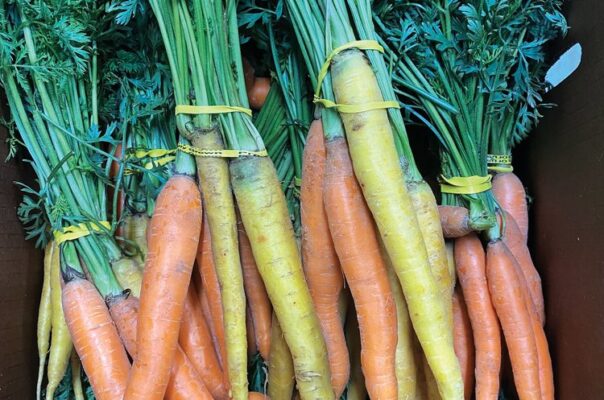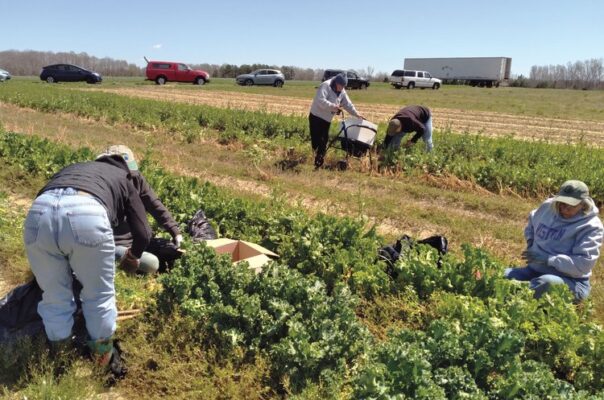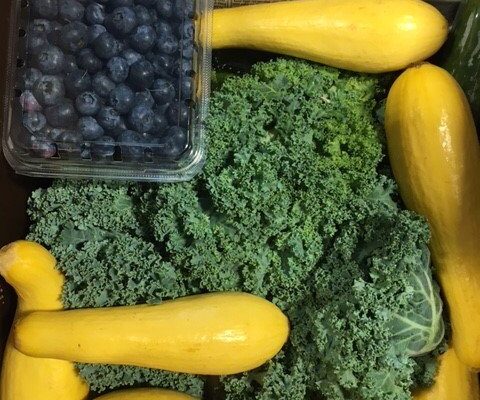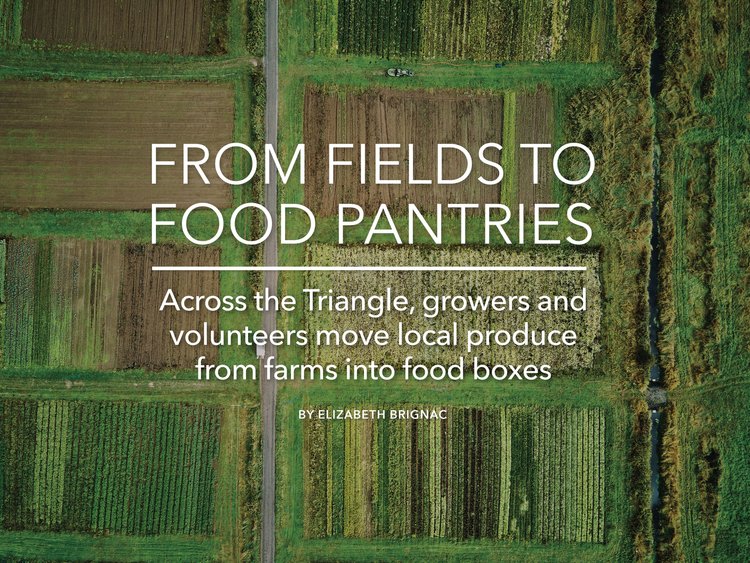Article:
According to the U.S. Department of Agriculture, North Carolina is the 10th highest agriculture-producing state in the nation. It also has the 10th highest number of food-insecure citizens. Approximately 1.6 million North Carolinians struggle to find the food they need, and a quarter-million of those people live in the Triangle.
With 470,000 acres of farmland in the Triangle region (according to the USDA Agricultural Census), access to fresh produce shouldn’t be a problem for local residents. Farmers and hunger relief agencies agree. They are working together to get produce, eggs and dairy products from local farms to families who aren’t always sure where their next meal will come from.
Who Donates?
Most farmers deliberately grow more than they can sell in order to accommodate possible crop damage. Many of them donate unsold produce to food banks and food pantries. Much of what they donate doesn’t hit the high aesthetic standards of retail markets—it may be discolored or oddly shaped—but it’s still good to eat. “[Farmers] don’t want to see it thrown away,” says Michael Binger, Carolinas regional director for the Society of St. Andrew (SOSA), an organization that harvests and delivers donated produce to service organizations. “They’d rather have somebody benefit from it.”
Large-scale food suppliers like the Food Bank of Central and Eastern North Carolina receive most of this produce. They sort through it, remove damaged food and make it available to neighborhood food pantries.
Farmers also donate produce directly to local pantries rather than going through food banks. Some grow food specifically for food pantries. “We have one farmer who plants fields of collards and kale and turnip greens exclusively to harvest to bring to us,” says Michael Burger, board chair of the Tri-Area Ministry Food Pantry.
Community gardens donate first-rate produce as well. Even small family plots supply vegetables. “A lot of people will come by and donate stuff to us from their backyard gardens,” Burger says.
Volunteers Harvest and Deliver Food
Often, teams of volunteers harvest donated crops and transport produce to hunger relief agencies. SOSA does much of this work in the Triangle. The organization sometimes transports already-harvested produce from farms to food banks. They also bring volunteers out to harvest crops that would otherwise go to waste, delivering the harvest to food distribution centers. “Over the past 30 years, we’ve built relationships with schools, church groups, community groups, individuals. We’ve got a few thousand volunteers every year out of the Triangle,” Binger says. A popular volunteer event is the Yam Jam, a sweet potato harvesting event SOSA holds every fall. Sweet potatoes, plentiful in North Carolina, are nutritious produce with a lengthy shelf life that makes them ideal for food banks.
SOSA gains access to fields due to its reputation for treating farmers’ property with respect and its coverage of liability insurance. Last year, the work of 2,000 SOSA volunteers moved approximately 11 million servings of food from fields into food boxes.
Supporting Local Farmers
Ironically, some who experience food insecurity are those who grow the food. According to the North Carolina Farmworker Health Program, almost half of the state’s farmworker households experience food insecurity. Keeping a small or mid-size farm going has been a challenge in recent years, and the COVID pandemic represented a disaster for many already-struggling farmers.
Organizations that support local agriculture have found ways to donate food to those in need while creating markets for small and mid-size growers. The Carolina Farm Stewardship Association opened its FarmsSHARE program in 2020 in response to the COVID-19 pandemic. “When lockdown went into place, we immediately were hearing about a lot of issues being caused by the farmers markets being shut down—the panic that set in as restaurants were closing and farmers were losing their markets overnight,” says Kana Miller, CFSA’s local food distribution coordinator.
CFSA partners with food hubs—organizations that connect local farmers with potential customers. Working with local culinary organizations, CFSA applied for grant money to supply funds to food hubs so they could purchase boxes of produce from farmers. The food hubs distributed these produce boxes to restaurant workers who had lost their jobs due to the pandemic. Thus, they provided business for the farmers and food for the unemployed workers. Now serving a general population of food-insecure people, FarmsSHARE paid more than $1,400,000 to local farmers and food hubs while distributing 34,461 boxes of food to people in need between the summers of 2020 and 2021.
Farmer Foodshare in Durham works with CFSA and other organizations to support local farmers while feeding low-income consumers. “We believe that people of all income levels deserve to eat the food that’s grown in their local foodsheds,” says Kelly Crane, executive director for Farmer Foodshare. The organization’s Food Hub program buys food from local farmers and either sells or donates it. Half the food goes to paying clients. The other half goes to hunger relief agencies. The Food Hub program offers farmers the flexibility to increase their output gradually, gain necessary permits and certifications, reach a larger market, and buy the equipment they need so they can eventually sell produce in bulk to retailers. Meanwhile, hunger relief agencies and other community partners gain access to inexpensive, quality local produce.
Programs like these seek more than short-term financial assistance for farmers. They work for a fundamental change in how communities think about buying and donating food. Rural Advancement Foundation International’s Come to the Table program, for example, brings faith communities together with local farmers of color in mutually beneficial, community-supported agricultural relationships. RAFI has built on those relationships, offering small grants for congregations to buy CSA boxes for donation to food pantries. The program’s goal is to encourage partner congregations to put funds toward sourcing the food they donate to food pantries from local farmers. “I want to see hearts and minds in these congregations changed so that they just naturally want to support farmers of color and want to participate more directly in their local food systems,” says Justine Post, director of Come to the Table. “That [approach], long-term, addresses economic insecurity, and it addresses social and racial justice.”
Community Support
Food insecurity grew exponentially during COVID-19. Miguel Rubiera, who manages Iglesia Emanuel Food Pantry in Durham, describes their pantry’s growth during the pandemic. “From 60 or 70 families, we went to 100 and 200. We started doing a lot of fundraising, grant writing, she says. “We thought the maximum number of families we could serve here was about 250. Now we serve between 630 and 650 families every week. And we aresad because we still have to send a lot of people away without food.”
Across the Triangle, food prices are high and food insecurity persists. Here are some ways you can help.
Volunteer. Work at your local food pantry or with SOSA to harvest and transport crops. Every service organization interviewed for this story expressed a need for volunteers.
Donate money and produce. Programs like Durham’s Plant-a-Row and Logan’s Garden Shop’s Plant a Row for the Hungry connect small farmers and backyard gardeners with food distribution centers. You can also bring produce directly to your local food pantry.
Build community relationships. Make connections between groups you belong to and organizations like Farmer Foodshare, whose proceeds support local farmers and bring quality produce to hunger relief agencies.
Support local farmers. Purchase groceries at farmers markets and subscribe to CSAs.







